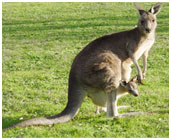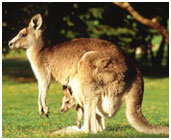Kangaroo is the largest living marsupial on the planet. Read further to get some more interesting facts and amazing information about kangaroo.
Facts About Kangaroo
Kangaroo, found mostly in Australia, is the largest living marsupial. You must have read about this animal in science books but did you know that there are as many as 47 species of kangaroo, known to mankind. An adult, large kangaroo can hop up to 5 meters i.e., nearly 16 feet in a single leap. You will be further surprised to know that kangaroo makes balance on its tail and use its forelimbs to grab the rival, while fighting. If these facts have boggled your mind, then read on to get much more interesting information about kangaroo. 

Class: Mammalia
Order: Marsupialia
Family: Macropodidae
Genus: Macropus
Range: Australia, New Guinea, Tasmania
Life Span: About 12 to 18 years
Names:
Young Kangaroo: Joey
Group of Kangaroos: Mob
Adult Male: Buck, Jack
Adult Female: Doe, Flyer or Jill
Dominant Male in Mob: Boomer
Size: Largest: Red Kangaroos (grow about 1.5 m and weigh up to 90 kg)
Smallest: Rat kangaroos (grow about 25 cm and weigh just 18 oz)
Habitat: Depend on the species, could be different habitats, including woodlands, arid grasslands, shrub steppe, salt pans, and rocky areas.
Eating Habits: Most kangaroos are herbivores; they generally eat grass and other plants. Some are omnivores, and they eat plants, insects, and small animals.
Eating Habits: Most kangaroos are herbivores; they generally eat grass and other plants. Some are omnivores, and they eat plants, insects, and small animals.
Offspring: Usually a female kangaroo have one baby annually. After a gestation period of 33 days, the kangaroo give birth to one baby. The newborn crawls into the mother’s pouch to develop completely. The Joey comes out after 5-9 months.
More Interesting Facts About Kangaroo
- A kangaroo is a marsupial from the family Macropodidae (macropods, suggesting ‘large foot’).
- It’s a general myth that Kangaroo got its name by a mere confusion. When the European explorers saw these strange animals for first, they asked a native Australian what they were called. The native replied “kangaroo” meaning ‘I don't understand you’. The explorers understood it to be the animal’s name. And ever since, the animal is known as kangaroo.
- A kangaroo moves by hopping on its strong hind legs. To balance its body while hopping, kangaroo uses its thick long tail. If you lift its tail off the ground, a kangaroo can’t hop.
- A kangaroo can hop at up to 60kmh. It can also jump over obstacles up to 3m (10ft) high.
- A kangaroo can’t walk or move backwards easily because of its bulky tail and unusual shape of its legs.
- A male kangaroo is called a boomer, while a female is known as a flyer.
- Male kangaroos don’t have pouches that the female kangaroos have.
- There are as many as 47 species of kangaroo, varying in size from the two-pound rock wallaby to the 300-pound red kangaroo.
- Kangaroos are found in Australia, Tasmania, and New Guinea.
- Most of the kangaroos are terrestrial. They are herbivorous, and live by grazing on plants.
- Each long, narrow hind foot of a kangaroo has four toes. The shorter forelimbs are used just like human arms, but the thumb is not opposable.
- Kangaroos have soft, wooly fur. Some of them even have stripes on the head, back, or upper limbs.
- Kangaroos have a chambered stomach that is practically similar to those of cattle and sheep. They regurgitate the plant they have eaten, chew it as cud, and again swallow it for final digestion.
- Kangaroos require very little water to survive; they are capable of going for months without drinking water at all. Whenever they need water, they dig ‘wells’ (normally 3-4 feet deep) for themselves.
- Kangaroos travel in groups, which are called mobs, under the leadership of the largest male, known as old man, or boomer. A boomer dominates younger rivals by biting, kicking, and boxing.


See also
More from iloveindia.com
- Home Remedies | Ayurveda | Vastu | Yoga | Feng Shui | Tattoos | Fitness | Garden | Nutrition | Parenting | Bikes | Cars | Baby Care | Indian Weddings | Festivals | Party ideas | Horoscope 2015 | Pets | Finance | Figures of Speech | Hotels in India : Delhi | Hyderabad | Chennai | Mumbai | Kolkata | Bangalore | Ahmedabad | Jaipur
- Contact Us Careers Disclaimer Privacy Policy Advertise With Us Lifestyle Sitemap Copyright iloveindia.com. All Rights Reserved.




